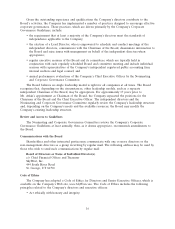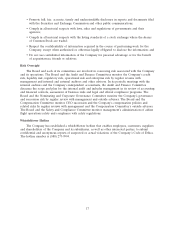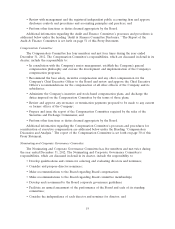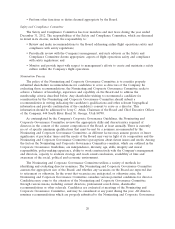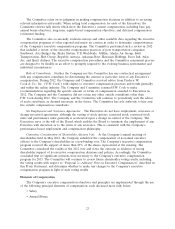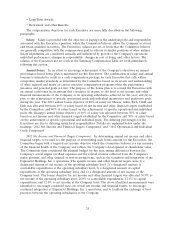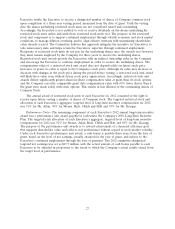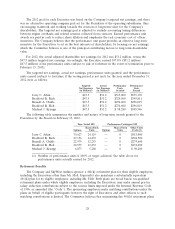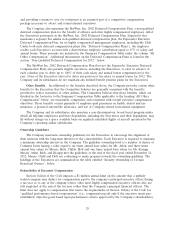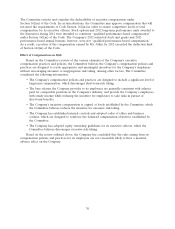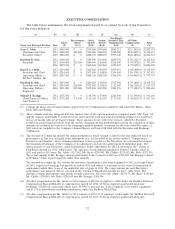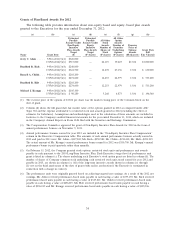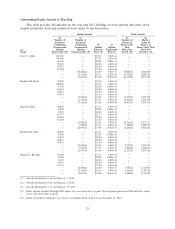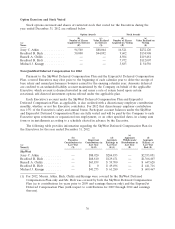SkyWest Airlines 2012 Annual Report Download - page 148
Download and view the complete annual report
Please find page 148 of the 2012 SkyWest Airlines annual report below. You can navigate through the pages in the report by either clicking on the pages listed below, or by using the keyword search tool below to find specific information within the annual report.upon a change in control of the Company, long-term incentive awards currently vest only if the
Executive remains employed by the Company for three years from the date of grant. The Committee
believes the three-year cliff-vesting schedule assists in retaining Executives and encourages the
Executives to focus on the Company’s long-term performance.
In granting stock options, restricted stock units and shares of restricted stock to the Executives, the
Committee also considers the impact of the grant on the Company’s financial performance, as
determined in accordance with the requirements of Financial Accounting Standards Board Accounting
Standards Codification Topic 718 (ASC Topic 718). For long-term equity awards, the Company records
expense in accordance with ASC Topic 718. The amount of expense recorded pursuant to ASC
Topic 718 may vary from the corresponding compensation value used in determining the amount of the
awards.
Amount and allocation of grant— For 2012 the total annual targeted long-term incentive grant
value was 139% of salary and targeted annual bonus for Mr. Atkin, 117% of salary and targeted annual
bonus for Messrs. Rich, Childs and Holt and 70% of salary and targeted annual bonus for Mr. Kraupp.
The Committee established these targeted amounts to provide a competitive pay package and to ensure
that a large portion of each Executive’s compensation was based on continuing long-term service and
correlated to the creation of shareholder value. This has been the Committee’s policy for several years,
but is subject to review and continuation or modification each year by the Committee. Mr. Atkin’s
targeted level of long-term incentive awards is higher than the targeted level of long-term incentive
awards for other Executives since he has overall responsibility for the long-term success of the
Company. Each Executive’s 2012 long-term incentive award was allocated among three types of
long-term awards as follows: stock options, restricted stock units and performance units payable in cash.
The three types of awards were used in an effort to link the Executives’ long-term incentive
compensation with the creation of shareholder value. The value of stock options and restricted stock
units is directly related to the value of the Common Stock. The Executives earn performance units
payable in cash by meeting return on shareholder equity objectives that the Committee believes also
lead to long-term shareholder value, but are not subject to short-term stock market volatility.
Stock options, restricted stock unit and performance unit grants in 2012 were made pursuant to
the Company’s 2010 Long-Term Incentive Plan, as shown in greater detail below in the table labeled
‘‘Grants of Plan Based Awards.’’
Stock Options—Options are granted with an exercise price equal to the closing price per share on
the date of grant and vest three years after the date of grant. Grants are made on a systematic
schedule, generally one grant per year made at the first Committee meeting of each year.
The purpose of stock options is to tie a significant percentage of the award’s ultimate value to
increases in the stock price, thereby rewarding increased value to the shareholders. A stock option only
has a value to the extent the value of the underlying shares on the exercise date exceeds the exercise
price. Accordingly, stock options provide compensation only if the underlying share price increases over
the option term and the Executive’s employment continues through the vesting date.
The size of the grant for each Executive is calculated by determining the number of shares with a
theoretical future value equal to the targeted compensation for stock options, assuming each option will
have a value equal to 33% of its exercise price. This value generally correlates to the ASC Topic 718
value of the awards. The targeted stock option allocation of each Executive’s aggregate, targeted level
of long-term incentive compensation for 2012 was 17% for Mr. Atkin, 18% for Messrs. Rich, Childs
and Holt and 15% for Mr. Kraupp.
Restricted Stock Units—The Company also granted restricted stock units to the Executives in 2012
under the Company’s 2010 Long-Term Incentive Plan. The restricted stock units awarded to an
26


